In a moment of wonder and elation 70 years ago this week, four French teenagers discovered more than just their missing dog.
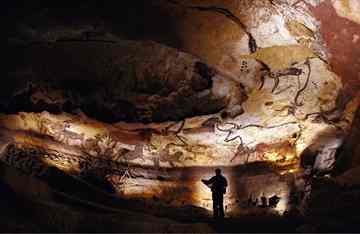 Lost in the woods outside the small medieval town of Montignac in Aquitaine, the pup had fallen into a small cavern in the ground. As the cavalier bereted tough-guy of the group Marcel Ravidat lowered himself in to explore a bit further, his eyes feasted on one of the most spectacular cultural artifacts remaining from deeply prehistoric times. Dozens of colorful images of animals careened along the walls and overhead.
Lost in the woods outside the small medieval town of Montignac in Aquitaine, the pup had fallen into a small cavern in the ground. As the cavalier bereted tough-guy of the group Marcel Ravidat lowered himself in to explore a bit further, his eyes feasted on one of the most spectacular cultural artifacts remaining from deeply prehistoric times. Dozens of colorful images of animals careened along the walls and overhead.
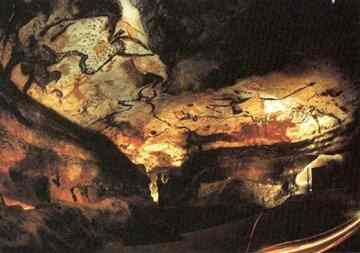 Over the next several days the teenagers returned to the cave, explored further, and reported back to their teacher. The teacher contacted legendary local cave art specialist the abbe Henri Breuil, who made extensive documentation of the images, and soon visitors from near and far were flocking to see these ancient pictures.
Over the next several days the teenagers returned to the cave, explored further, and reported back to their teacher. The teacher contacted legendary local cave art specialist the abbe Henri Breuil, who made extensive documentation of the images, and soon visitors from near and far were flocking to see these ancient pictures.
A Prehistoric Masterpiece
Lascaux was not the first decorated cave to be discovered in France, nor is it the largest, oldest, or most decorated. But still, it has a character all its own which has continued to draw attention for the past 70 years.
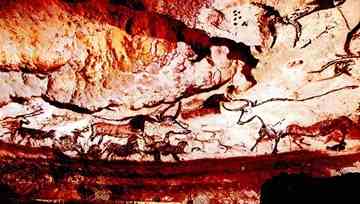 Almost all known decorated caves feature a combination of painting, drawing, and engraving. They contain images of animals, enigmatic designs and patterns, the rare portrayal of a human being, and often handprints of those who visited there just after the most recent ice age (certainly not "the last ice age," as geologically speaking, we're soon due for another).
Almost all known decorated caves feature a combination of painting, drawing, and engraving. They contain images of animals, enigmatic designs and patterns, the rare portrayal of a human being, and often handprints of those who visited there just after the most recent ice age (certainly not "the last ice age," as geologically speaking, we're soon due for another).
What Lascaux does offer uniquely in France I a colorfulness and apparent cohesion which implies the kind of coordinated vision and activity that many tend to associate only with "modern" human. Large aurochs, stags, and horses appear in similar styles and scale, superimposed over countless smaller images.
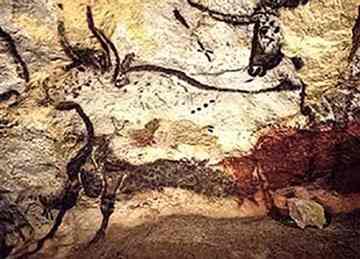 Recent analysis has shown that the animals throughout the cave were painted in a consistent order: horses first, then aurochs, then stags.
Recent analysis has shown that the animals throughout the cave were painted in a consistent order: horses first, then aurochs, then stags.
In "Lascaux: Movement, Space, and Time," veteran cave explorer and innovative photographer Norbert Aujoulat points out that this is also the order in which those animals have their breeding seasons, in spring, summer, and fall respectively. We are currently unable to say however, whether the images were painted successively in a matter of hours, days, months, or years.
Life in Color
The fabulous colors of the paintings are taken directly from the Earth itself: yellow and red ochre are in the soil of much of the region, and deep black manganese dioxide is plentiful inside and outside the caves.
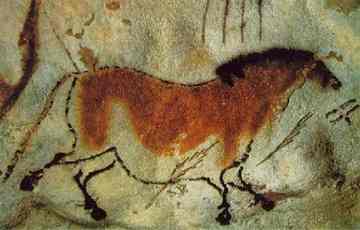 It was prepared by mixing it with liquid and applied by brush, pad, or spraying from the mouth or through a thin tube. Masking the edges with an unknown implement (possibly just a hand) allowed even the sprayed pigment to have sharply defined edges when desired.
It was prepared by mixing it with liquid and applied by brush, pad, or spraying from the mouth or through a thin tube. Masking the edges with an unknown implement (possibly just a hand) allowed even the sprayed pigment to have sharply defined edges when desired.
Several in-between shades were achieved through mixing, and they are all used to make animals stand out or tie together in various ways throughout the cave.
Space and Time
Perhaps the most interesting use in Lascaux of the spraying technique is not where it is given an edge though, but where the edge is allowed to fade out. While westerners often think that the illusion of depth in illustration was first developed in the Renaissance, a quickly look at frescoes from Roman Pompeii destroys that notion.
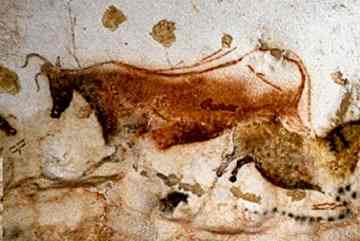 Images with a strong resemblance to the subject's physical appearance have appeared at many times and in many places. Even in the world of rock art, engravings and paintings from Africa show that late-Pleistocene Europeans weren't the only culture to develop this style. Still, it is fairly rare. More schematic representations are the norm throughout the world.
Images with a strong resemblance to the subject's physical appearance have appeared at many times and in many places. Even in the world of rock art, engravings and paintings from Africa show that late-Pleistocene Europeans weren't the only culture to develop this style. Still, it is fairly rare. More schematic representations are the norm throughout the world.
The perspective in Lascaux was not achieved through use of converging lines and focal points, but by variation in clarity and size. Almost all of the animals are shown in profile position. This means either their left or right limbs are then further from the viewer.
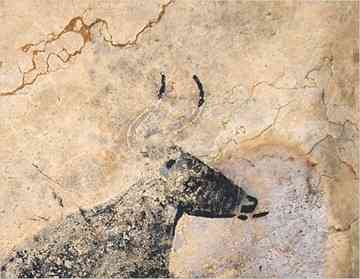 Instead of drawing four limbs straight down as a modern child might, the Lascaux artists left a faded-out gap between the strong, clear line o the body and the shape of the more distant limbs. The most elaborate use of this comes with the two crossed bison where hind limbs all overlap, but in a fairly clear way, thanks to this gap technique.
Instead of drawing four limbs straight down as a modern child might, the Lascaux artists left a faded-out gap between the strong, clear line o the body and the shape of the more distant limbs. The most elaborate use of this comes with the two crossed bison where hind limbs all overlap, but in a fairly clear way, thanks to this gap technique.
A third technique utilized to striking effect at Lascaux, though present in many of the caves in the area is the illusion of motion.
In modern still images, we have several ways of indicating motion: blurred regions, repeated lines either following the shape of something or perpendicular to the direction of motion. For prehistoric image-makers, the technique seems to have been repetition. In some caves this comes in the form of "too many" limbs on a body, but at Lascaux it is best shown through repetition of entire figures.
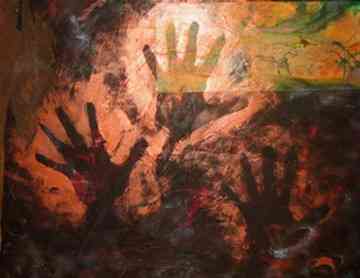 When one first enters the cave, on the upper part of the left wall and on to the ceiling is a series of horses. There are many horses in Lascaux, and all have distinct coloring and proportions. As our tour guide pointed out, all of these entry-hall horses have the same coloring and the same unusually small head. There are eight of them of varying levels of detail, completion, and preservation, but what is most striking is that the legs of each are in different positions in the gait of a running horse.
When one first enters the cave, on the upper part of the left wall and on to the ceiling is a series of horses. There are many horses in Lascaux, and all have distinct coloring and proportions. As our tour guide pointed out, all of these entry-hall horses have the same coloring and the same unusually small head. There are eight of them of varying levels of detail, completion, and preservation, but what is most striking is that the legs of each are in different positions in the gait of a running horse.
In the complete darkness of a cave, an animal-fat candle moved along the wall would show each of these in succession, providing a highly evocative sense of the motion of one animal running along the wall and receding into the distance. Even if seen as a series of separate individuals, the alternation of visibility, size, and leg position still manages to describe a range of motion and not just a single snapshot.
A Town Celebrates
The color, physical realism and sense of motion all combine to make seeing Lascaux an unforgettable experience. As such, it has become the pride, joy, and bread basket for Montignac.
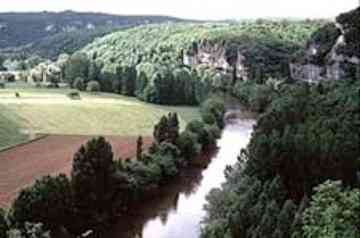 So it was with little surprise, but much excitement, that one entered the town this past weekend. Garlands of artificial flowers formed a canopy over the town's main street and side alleys, casting the scene below in glowing shades of yellow, pink, and blue. The shops, the residents, the stray dogs and the president of France himself, Nicholas Sarkozy were painted in this light.
So it was with little surprise, but much excitement, that one entered the town this past weekend. Garlands of artificial flowers formed a canopy over the town's main street and side alleys, casting the scene below in glowing shades of yellow, pink, and blue. The shops, the residents, the stray dogs and the president of France himself, Nicholas Sarkozy were painted in this light.
After typical small town festivities and honors, Sarkozy met with top archaeologists, including Jean Clottes, fresh from the week-long conference on prehistoric art around the world a few hours south at the foot of the Pyrenees, a region dense with decorated caves.
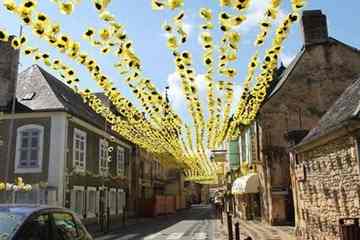 In honor of the celebration, the president was even allowed an exceedingly rare opportunity to enter the original cave itself. Years of unbounded visiting and botched attempts at air conditioning have led to the growth of a pervasive fungus which threatens to cover and perhaps destroy these exceptional images. Since 1983, all other visitors have viewed an elaborate underground replica called Lascaux II.
In honor of the celebration, the president was even allowed an exceedingly rare opportunity to enter the original cave itself. Years of unbounded visiting and botched attempts at air conditioning have led to the growth of a pervasive fungus which threatens to cover and perhaps destroy these exceptional images. Since 1983, all other visitors have viewed an elaborate underground replica called Lascaux II.
Some purists contend that not being the real thing, this replica is hardly worth the visit. What that perspective misses out on through is the simple aesthetic value of this replica and the original. What the replica does is allow you to see the images in their actual relationship to each other and just as importantly, to the walls.
Something that is almost never discernable in photographs is how much the ancient art makers used the surface of the rocks themselves to help define shape and volume. The undulations form bulges and hollows that give mass and direction to shoulders, hips, and bellies.
What Lascaux II lacks in Romantic atmosphere it makes up for in its celebration of the art itself - one of its functions then is to help us realize that these are amazing images in a well-chosen space, whether painted 18,000 years ago or 27.
Click on this link to visit the official Lascaux site.
Author: Andrew Howley | Source: National Geographic [September 17, 2010]